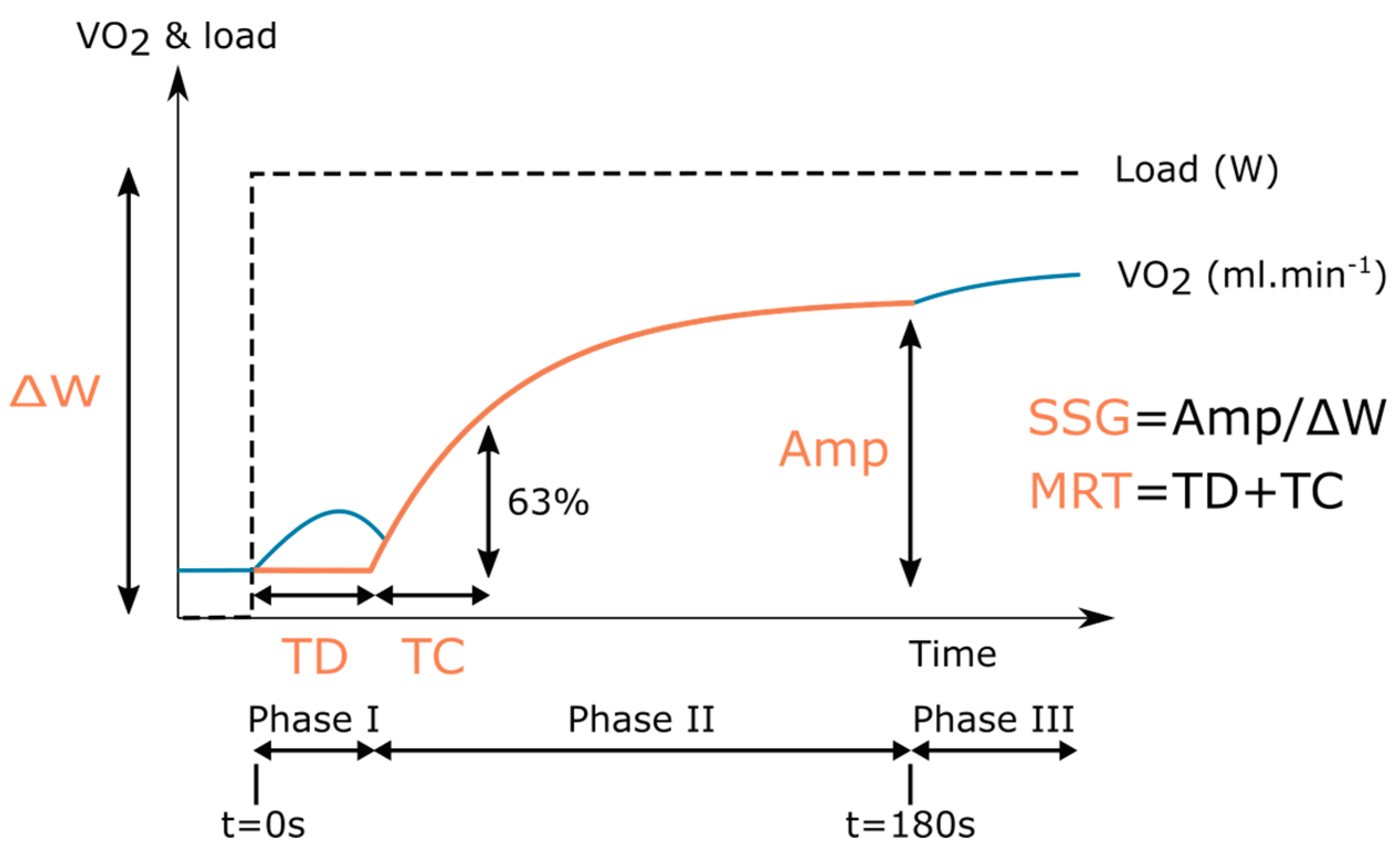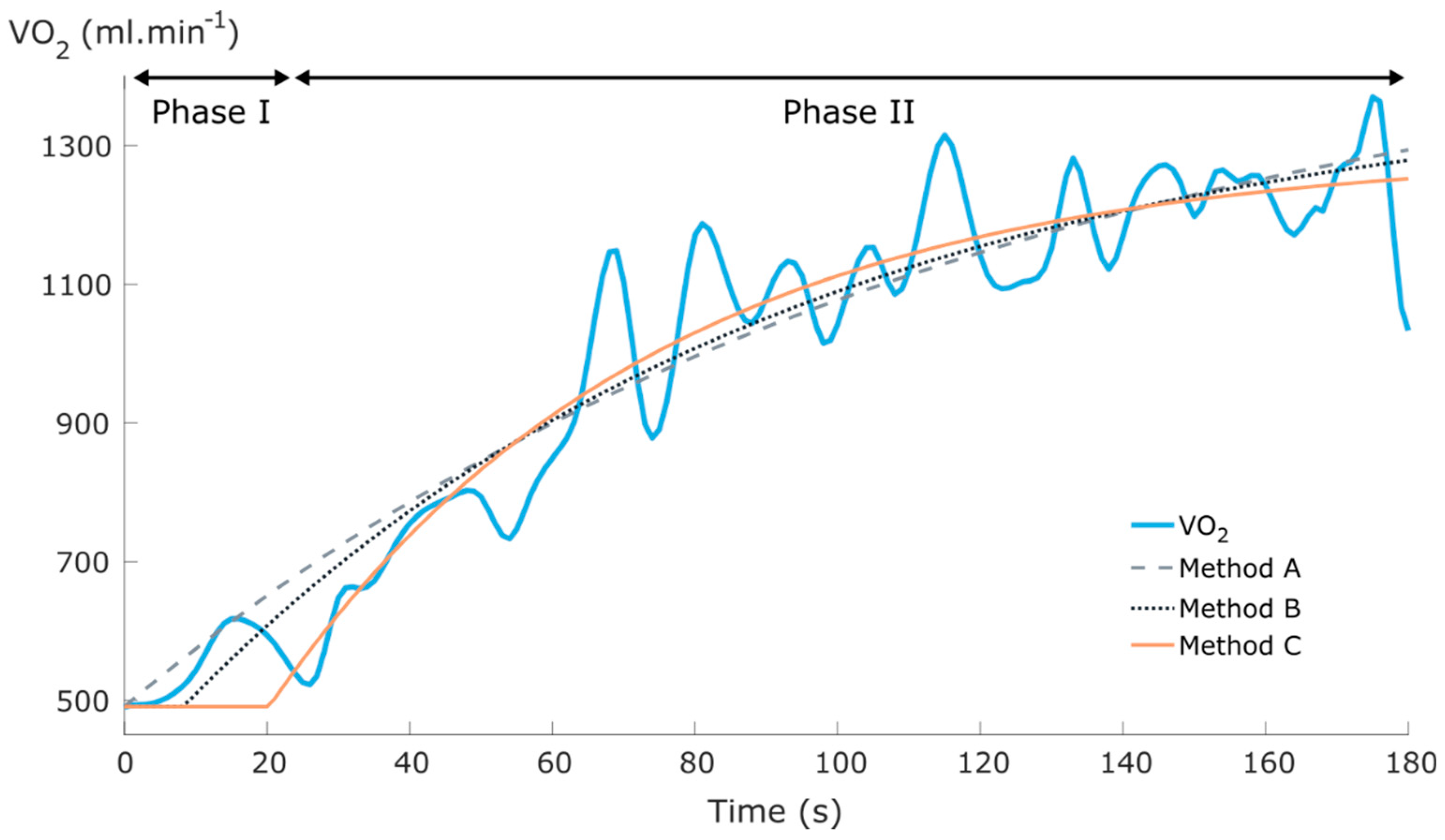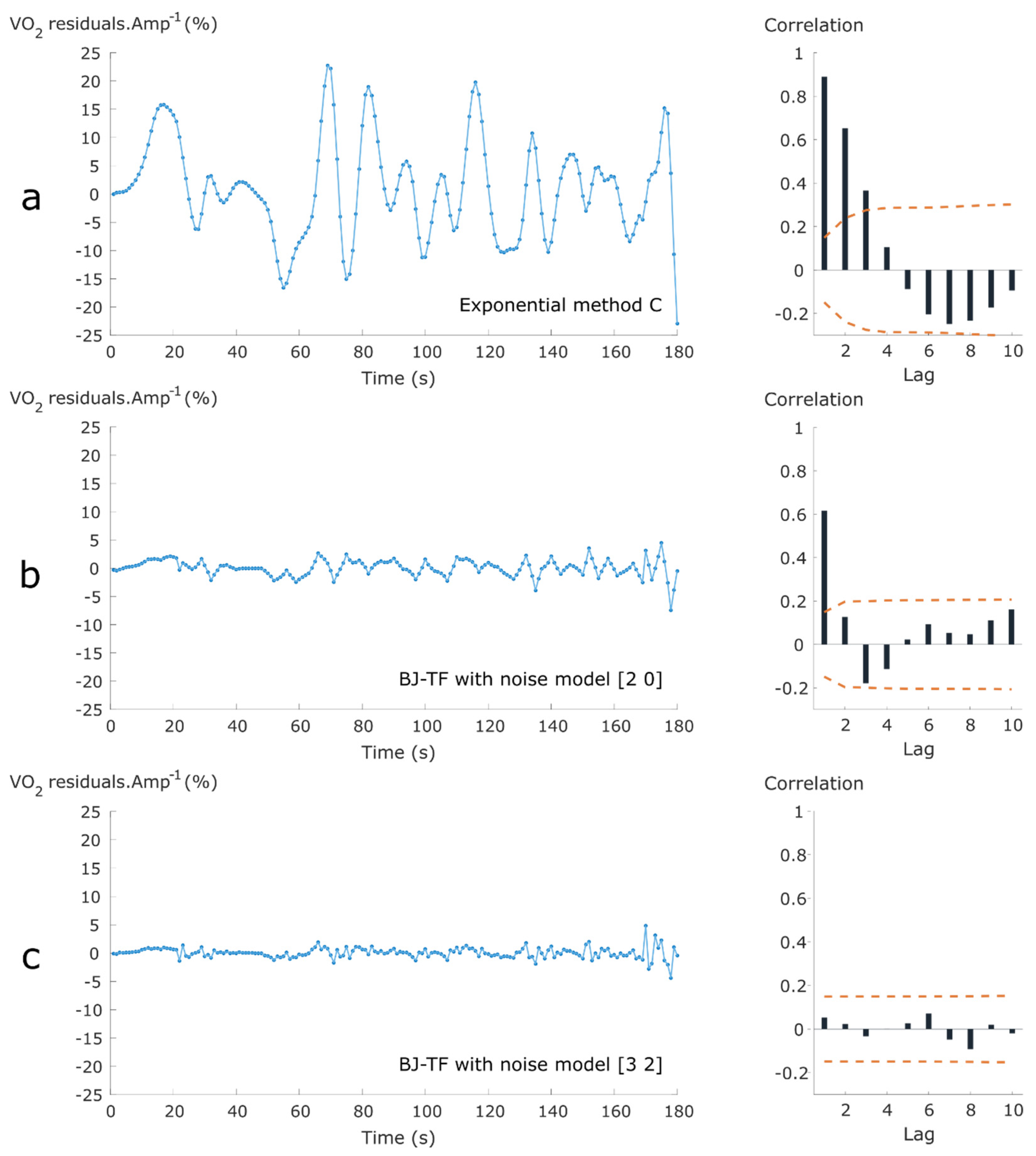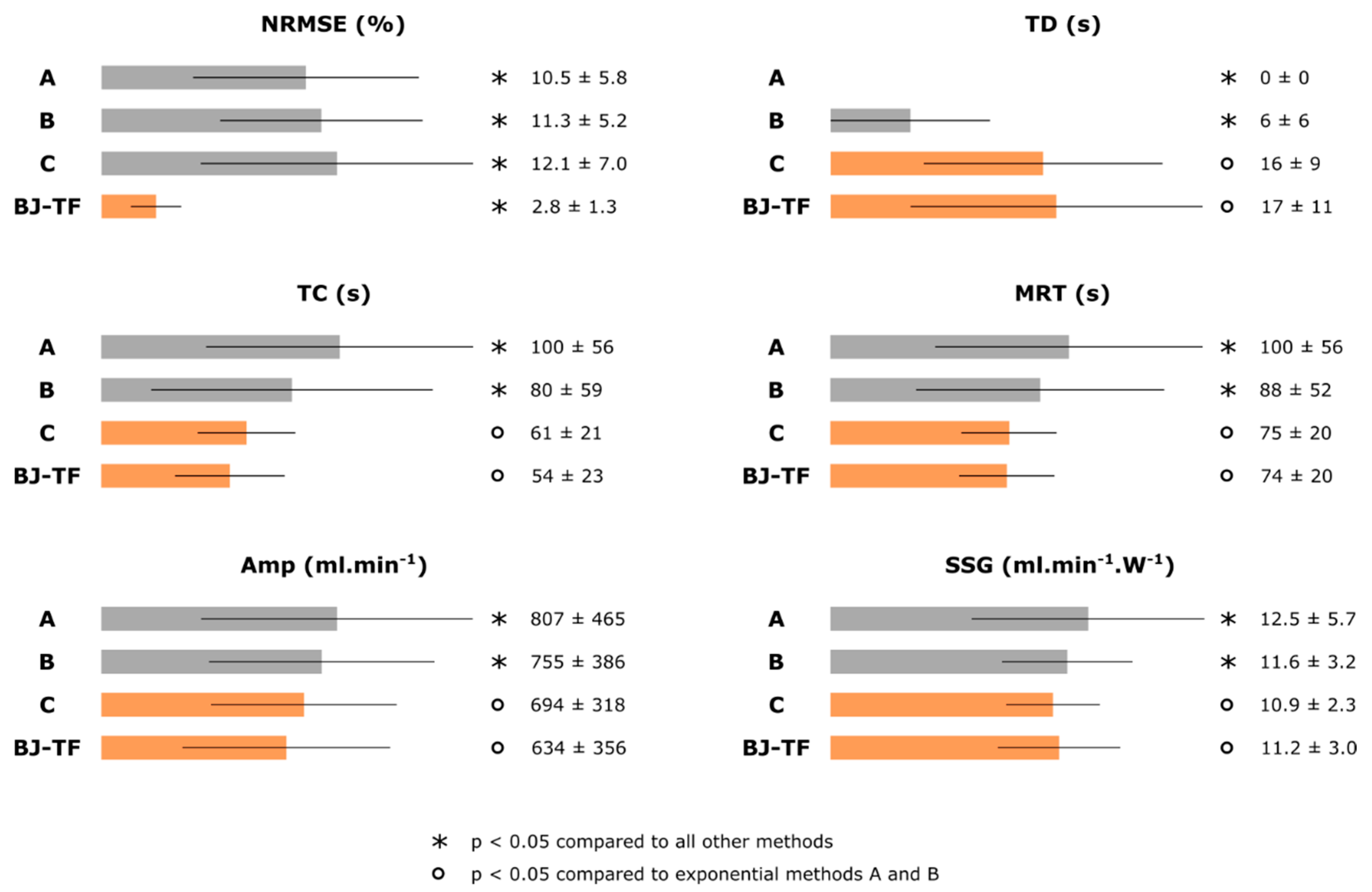Box-Jenkins Transfer Function Modelling for Reliable Determination of VO2 Kinetics in Patients with COPD
Abstract
:1. Introduction
2. Materials and Methods
2.1. Study Design and Participants
2.2. Exercise Testing
2.3. Data Pre-Processing
2.4. Kinetic Analyses
2.5. Statistical Analysis
3. Results
3.1. Exponential Modelling
3.2. Box-Jenkins Transfer Function Modelling
3.3. Kinetic Features
4. Discussion
Author Contributions
Funding
Acknowledgments
Conflicts of Interest
References
- Global Initiative for Chronic Obstructive Lung Disease (GOLD). Global strategy for the diagnosis, management, and prevention of Chronic Obstructive Pulmonary Disease—2019 Report 2019. Available online: https://goldcopd.org/wp-content/uploads/2018/11/GOLD-2019-v1.7-FINAL-14Nov2018-WMS.pdf (accessed on 30 January 2019).
- Watz, H.; Pitta, F.; Rochester, C.L.; Garcia-Aymerich, J.; ZuWallack, R.; Troosters, T.; Vaes, A.W.; Puhan, M.A.; Jehn, M.; Polkey, M.I.; et al. An official European respiratory society statement on physical activity in COPD. Eur. Respir. J. 2014, 44, 1521–1537. [Google Scholar] [CrossRef] [PubMed]
- American Thoracic Society (ATS); American College of Chest Physicians (ACCP). ATS/ACCP Statement on cardiopulmonary exercise testing. Am. J. Respir. Crit. Care Med. 2003, 167, 211–277. [Google Scholar] [CrossRef] [PubMed]
- Poole, D.C.; Jones, A.M. Towards an understanding of the mechanistic bases of VO2 kinetics. Compr. Physiol. 2012, 2, 933–996. [Google Scholar]
- Nery, L.E.; Wasserman, K.; Andrews, J.D.; Huntsman, D.J.; Hansen, J.E.; Whipp, B.J. Ventilatory and gas exchange kinetics during exercise in chronic airways obstruction. J. Appl. Physiol. 1982, 53, 1594–1602. [Google Scholar] [CrossRef] [PubMed]
- Somfay, A.; Porszasz, J.; Lee, S.-M.; Casaburi, R. Effect of hyperoxia on gas exchange and lactate kinetics following exercise onset in nonhypoxemic COPD patients. Chest 2002, 121, 393–400. [Google Scholar] [CrossRef] [PubMed]
- Palange, P.; Galassetti, P.; Mannix, E.T.; Farber, M.O.; Manfredi, F.; Serra, P.; Carlone, S. Oxygen effect on O2 deficit and VO2 kinetics during exercise in obstructive pulmonary disease. J. Appl. Physiol. 1995, 78, 2228–2234. [Google Scholar] [CrossRef] [PubMed]
- Laveneziana, P.; Palange, P.; Ora, J.; Martolini, D.; O’Donnell, D.E. Bronchodilator effect on ventilatory, pulmonary gas exchange, and heart rate kinetics during high-intensity exercise in COPD. Eur. J. Appl. Physiol. 2009, 107, 633–643. [Google Scholar] [CrossRef]
- Berton, D.C.; Barbosa, P.B.; Takara, L.S.; Chiappa, G.R.; Siqueira, A.C.B.; Bravo, D.M.; Ferreira, L.F.; Neder, J.A. Bronchodilators accelerate the dynamics of muscle O2 delivery and utilisation during exercise in COPD. Thorax 2010, 65, 588–593. [Google Scholar] [CrossRef] [PubMed]
- Puente-Maestu, L.; Sánz, M.L.; Sánz, P.; De Oña, J.M.R.; Rodríguez-Hermosa, J.L.; Whipp, B.J. Effects of two types of training on pulmonary and cardiac responses to moderate exercise in patients with COPD. Eur. Respir. J. 2000, 15, 1026–1032. [Google Scholar] [CrossRef]
- Faisal, A.; Zoumot, Z.; Shah, P.L.; Neder, J.A.; Polkey, M.I.; Hopkinson, N.S. Effective bronchoscopic lung volume reduction accelerates exercise oxygen uptake kinetics in emphysema. Chest 2016, 149, 435–446. [Google Scholar] [CrossRef] [PubMed]
- Chiappa, G.R.; Borghi-Silva, A.; Ferreira, L.F.; Carrascosa, C.; Oliveira, C.C.; Maia, J.; Gimenes, A.C.; Queiroga, F.; Berton, D.; Ferreira, E.M.V.; et al. Kinetics of muscle deoxygenation are accelerated at the onset of heavy-intensity exercise in patients with COPD: Relationship to central cardiovascular dynamics. J. Appl. Physiol. 2008, 104, 1341–1350. [Google Scholar] [CrossRef]
- Box, G.E.; Jenkins, G.M.; Reinsel, G.C.; Ljung, G.M. Time Series Analysis, 4th ed.; Quigley, S., Van Horn, L., Eds.; John Wiley & Sons, Inc.: New York, NY, USA, 2008; ISBN 9780470272848. [Google Scholar]
- Spruit, M.A.; Vanderhoven-Augustin, I.; Janssen, P.P.; Wouters, E.F. Integration of pulmonary rehabilitation in COPD. Lancet 2008, 371, 12–13. [Google Scholar] [CrossRef]
- Pedregal, D.J.; Taylor, C.J.; Young, P.C. System Identification, Time Series Analysis and Forecasting: The Captain Toolbox handbook; Lancaster University: Lancaster, UK, 2007. [Google Scholar]
- Young, P.C. Recursive Estimation and Time-Series Analysis: An. Introduction for the Student and Practitioner, 2nd ed.; Springer: Berlin/Heidelberg, Germany; New York, NY, USA, 2011; ISBN 978-3-642-21980-1. [Google Scholar]
- Taylor, C.J.; Pedregal, D.J.; Young, P.C.; Tych, W. Environmental time series analysis and forecasting with the Captain toolbox. Environ. Model. Softw. 2007, 22, 797–814. [Google Scholar] [CrossRef]
- Jones, N.L.; Makrides, L.; Hitchcock, C.; Chypchar, T.; McCartney, N. Normal Standards for an Incremental Progressive Cycle Ergometer Test. Am. Thorac. Soc. J. 1985, 131, 700–708. [Google Scholar]
- Whipp, B.J.; Ward, S.A.; Lamarra, N.; Davis, J.A.; Wasserman, K. Parameters of ventilatory dynamics during exercise. J. Appl. Physiol. Respir. Environ. Exerc. Physiol. 1982, 52, 1506–1513. [Google Scholar]
- Bell, C.; Paterson, D.H.; Kowalchuk, J.M.; Padilla, J.; Cunningham, D.A. A comparison of modelling techniques used to characterise oxygen uptake kinetics during the on-transient of exercise. Exp. Physiol. 2001, 86, 667–676. [Google Scholar] [CrossRef] [PubMed]
- Spencer, M.D.; Murias, J.M.; Lamb, H.P.; Kowalchuk, J.M.; Paterson, D.H. Are the parameters of VO2, heart rate and muscle deoxygenation kinetics affected by serial moderate-intensity exercise transitions in a single day? Eur. J. Appl. Physiol. 2011, 111, 591–600. [Google Scholar] [CrossRef]
- Lamarra, N.; Whipp, B.J.; Ward, A.; Wasserman, K. Effect of interbreath fluctuations on characterizing exercise gas exchange kinetics. J. Appl. Physiol. 1987, 62, 2003–2012. [Google Scholar] [CrossRef]
- Puente-Maestu, L.; Buendía Abad, M.J.; Godoy, R.; Pérez-Parra, J.M.; Cubillo, J.M.; Whipp, B.J. Breath-by-breath fluctuations of pulmonary gas exchange and ventilation in COPD patients. Eur. J. Appl. Physiol. 2002, 87, 535–541. [Google Scholar] [CrossRef] [PubMed]
- Markovitz, G.H.; Sayre, J.W.; Storer, T.W.; Cooper, C.B. On issues of confidence in determining the time constant for oxygen uptake kinetics. Br. J. Sports Med. 2004, 38, 553–560. [Google Scholar] [CrossRef]
- Söderström, T. Errors-in-Variables Methods in System Identification; Springer International Publishing: Cham, Switzerland, 2018; ISBN 978-3-319-75000-2. [Google Scholar]
- Murias, J.M.; Spencer, M.D.; Kowalchuk, J.M.; Paterson, D.H. Influence of phase I duration on phase II VO2 kinetics parameter estimates in older and young adults. Am. J. Physiol. Regul. Integr. Comp. Physiol 2011, 301, 218–224. [Google Scholar] [CrossRef] [PubMed]
- Kilding, A.E.; Challis, N.V.; Winter, E.M.; Fysh, M. Characterisation, asymmetry and reproducibility of on-and off-transient pulmonary oxygen uptake kinetics in endurance-trained runners. Eur. J. Appl. Physiol. 2005, 93, 588–597. [Google Scholar] [CrossRef]
- De Müller, P.T.; Christofoletti, G.; Zagatto, A.M.; Paulin, F.V.; Neder, J.A. Reliability of peak O2 uptake and O2 uptake kinetics in step exercise tests in healthy subjects. Respir. Physiol. Neurobiol. 2015, 207, 7–13. [Google Scholar] [CrossRef]
- Puente-Maestu, L.; Sánz, M.L.; Sánz, P.; Nuñez, A.; González, F.; Whipp, B.J. Reproducibility of the parameters of the on-transient cardiopulmonary responses during moderate exercise in patients with chronic obstructive pulmonary disease. Eur. J. Appl. Physiol. 2001, 85, 434–441. [Google Scholar] [CrossRef] [PubMed]
- Edwards, A.M.; Claxton, D.B.; Fysh, M.L. A comparison of two time-domain analysis procedures in the determination of VO2 kinetics by pseudorandom binary sequence exercise testing. Eur. J. Appl. Physiol. 2003, 88, 411–416. [Google Scholar] [CrossRef] [PubMed]
- Macfarlane, D.J. Open-circuit respirometry: A historical review of portable gas analysis systems. Eur. J. Appl. Physiol. 2017, 117, 2369–2386. [Google Scholar] [CrossRef]
- Van Remoortel, H.; Raste, Y.; Louvaris, Z.; Giavedoni, S.; Burtin, C.; Langer, D.; Wilson, F.; Rabinovich, R.; Vogiatzis, I.; Hopkinson, N.S.; et al. Validity of Six Activity Monitors in Chronic Obstructive Pulmonary Disease: A Comparison with Indirect Calorimetry. PLoS ONE 2012, 7, e39198. [Google Scholar] [CrossRef]
- Lefever, J.; Berckmans, D.; Aerts, J.-M. Time-variant modelling of heart rate responses to exercise intensity during road cycling. Eur. J. Sport Sci. 2014, 14, S406–S412. [Google Scholar] [CrossRef] [PubMed]





| Value Mean (SD) | |
|---|---|
| Age (years) | 63 (7) |
| Body mass index (kg/m2) | 26 (5) |
| Forced expiratory volume in 1 second (FEV1) % predicted | 48 (14) |
| Forced vital capacity (FVC) % predicted | 105 (18) |
| FEV1/FVC (%) | 37 (13) |
| Transfer factor for carbon monoxide % predicted | 55 (15) |
| Partial pressure of oxygen (kPa) | 8.8 (1.8) |
| Partial pressure of carbon dioxide (kPa) | 5.3 (0.7) |
| Modified Medical Research Council dyspnoea scores (scores 1-2-3) | 2-14-2 |
| CPET maximal cycling load % predicted [18] | 50 (23) |
| CPET maximal oxygen uptake (ml/min) | 1133 (231) |
| CPET maximal oxygen uptake % predicted [18] | 55 (21) |
| CWRT cycling load (W) | 57 (16) |
| CWRT endurance time (s) | 243 (81) |
| Order D(z−1) | ||||
|---|---|---|---|---|
| 1 | 2 | 3 | ||
| Order C(z−1) | 0 | −6.94 (2.31) | −5.69 (2.12) | |
| 2.8 (1.3) | 2.1 (1.1) | |||
| 1 | −6.82 (2.91) | −6.20 (2.11) | ||
| 2.5 (1.7) | 2.0 (2.6) | |||
| 2 | −6.75 (2.63) | −6.21 (2.69) | ||
| 2.1 (1.6) | 2.0 (1.6) | |||
| 3 | ||||
© 2019 by the authors. Licensee MDPI, Basel, Switzerland. This article is an open access article distributed under the terms and conditions of the Creative Commons Attribution (CC BY) license (http://creativecommons.org/licenses/by/4.0/).
Share and Cite
Buekers, J.; Theunis, J.; Peña Fernández, A.; Wouters, E.F.M.; Spruit, M.A.; De Boever, P.; Aerts, J.-M. Box-Jenkins Transfer Function Modelling for Reliable Determination of VO2 Kinetics in Patients with COPD. Appl. Sci. 2019, 9, 1822. https://doi.org/10.3390/app9091822
Buekers J, Theunis J, Peña Fernández A, Wouters EFM, Spruit MA, De Boever P, Aerts J-M. Box-Jenkins Transfer Function Modelling for Reliable Determination of VO2 Kinetics in Patients with COPD. Applied Sciences. 2019; 9(9):1822. https://doi.org/10.3390/app9091822
Chicago/Turabian StyleBuekers, Joren, Jan Theunis, Alberto Peña Fernández, Emiel F. M. Wouters, Martijn A. Spruit, Patrick De Boever, and Jean-Marie Aerts. 2019. "Box-Jenkins Transfer Function Modelling for Reliable Determination of VO2 Kinetics in Patients with COPD" Applied Sciences 9, no. 9: 1822. https://doi.org/10.3390/app9091822
APA StyleBuekers, J., Theunis, J., Peña Fernández, A., Wouters, E. F. M., Spruit, M. A., De Boever, P., & Aerts, J.-M. (2019). Box-Jenkins Transfer Function Modelling for Reliable Determination of VO2 Kinetics in Patients with COPD. Applied Sciences, 9(9), 1822. https://doi.org/10.3390/app9091822







